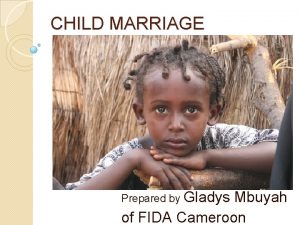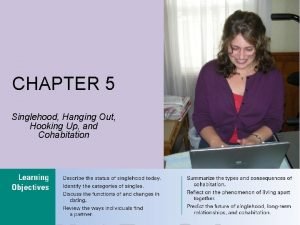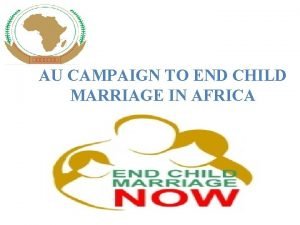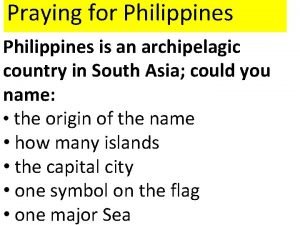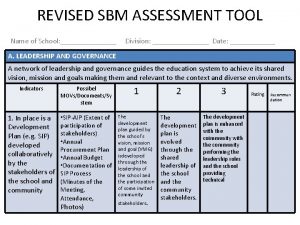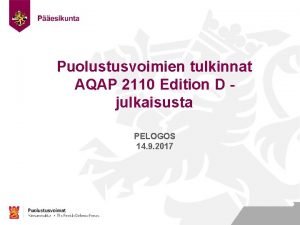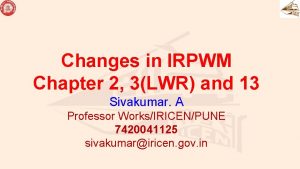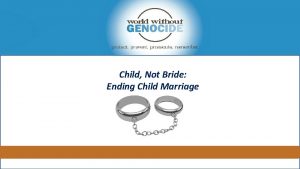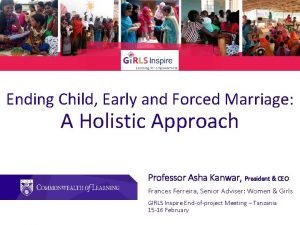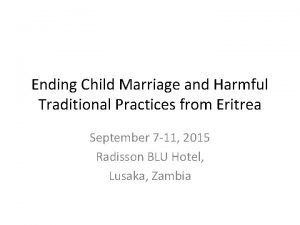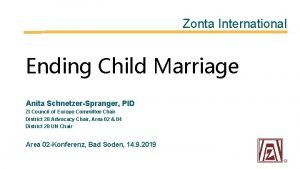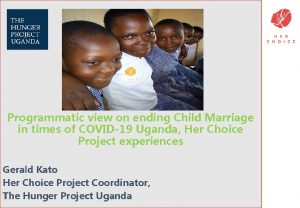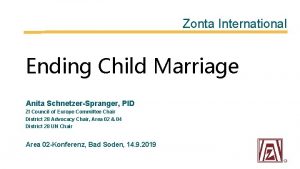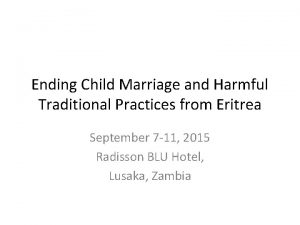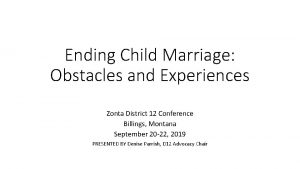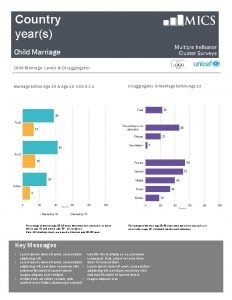Ending child marriage What does the latest evidence




















![Girls not Brides, February 2017 [title] Venkatraman Chandra-Mouli & Marina Plesons chandramouliv@who. int plesonsm@who. Girls not Brides, February 2017 [title] Venkatraman Chandra-Mouli & Marina Plesons chandramouliv@who. int plesonsm@who.](https://slidetodoc.com/presentation_image/28565618ad4f36dca491fa8eaa01d1c4/image-21.jpg)







- Slides: 28

Ending child marriage: What does the latest evidence say? THE FIRST DISCUSSION IN THE GIRLS NOT BRIDES 2018 LEARNING SERIES

Welcome to the Girls Not Brides 2018 Learning Series! • This webinar is the first in our series – you can find the programme for the next six months here

Ending child marriage: What does the latest evidence say? Why is evidence so important? Webinar objectives: • Give a snapshot of what we know from the latest evidence reviews • Demystify any differences in conclusions • Highlight on-going research and evidence gaps

Key resources and speakers Resources we will be discussing • Chae, S, and Ngo, TD, The global state of evidence on interventions to prevent child marriage, GIRL Center Research Brief No. 1. New York: Population Council, 2017 • Kalamar AM, Lee-Rife, Hindin MJ, Interventions to prevent child marriage among young people in low- and middle-income countries: a systematic review of the published and gray literature J Adolesc Health. 2016 Sep; 59(3 Suppl): S 16 -21. doi: 10. 1016/j. jadohealth, 2016 • Chandra-Mouli V, Lane C, Wong S. What does not work in adolescent sexual and reproductive health: a review of evidence on interventions commonly accepted as best practices. Glob Health Sci Pract. 2015; 3(3): 333 -340. 2015 Moderator: • Ellen Travers, Girls Not Brides secretariat Panellists: • Amanda Kalamar, Population Services International • Thoai Ngo, The Girl Center at Population Council • Venkatraman Chandra-Mouli, World Health Organisation Discussants: • Margaret Greene, Greene. Works • Rachel Marcus, Overseas Development Institute • Jeff Edmeades, ICRW

INTERVENTIONS TO PREVENT CHILD MARRIAGE AMONG YOUNG PEOPLE IN LOW- AND MIDDLEINCOME COUNTRIES: A SYSTEMATIC REVIEW OF THE PUBLISHED AND GRAY LITERATURE Amanda M. Kalamar, Ph. D. , Susan Lee-Rife, M. P. H. , Ph. D. , and Michelle J. Hindin, M. H. S. , Ph. D.

Objective, Strategy and Ranking ■ Identify high-quality interventions and evaluations to guide program managers, country officials, and donors to invest in successful approaches. ■ Searched published literature (Pub. Med, Embase, Psyc. Info, CINAHL Plus, Popline, and the Cochrane Databases) as well as gray literature through November 2015. ■ Multi-rater scoring of both the intervention and the evaluation and an overall ranking.

Selection Criteria ■ High quality intervention AND ■ High quality evaluation ■ Must have a behavioral outcome – Proportion of girls married – Age at marriage ■ Most recent analysis of the outcome

Summary Results

Discussion ■ Overall, of the >3, 900 articles screened from the published literature, we retained 6 (. 15%) and found five gray literature articles for a total of 11 highquality interventions and evaluations. Six had a statistically significant impact in the expected direction. ■ Most of the economic interventions (including cash transfers, school vouchers, payment of school-related costs) had a significant impact on reducing the proportion experiencing child marriage or increasing age at marriage. ■ Interventions with no statistical impact often had defined goals much broader than child marriage. ■ Range of strategies to address child marriage, providing flexibility for future impactful evidence-based programs suited to given context, population, or situation

Articles included in analysis: ■ Angrist J, Bettinger E, Bloom E, et al. Vouchers for private schooling in Colombia: Evidence from a randomized natural experiment. Am Econ Rev 2002; 92: 1535 e 58. ■ Gulemetova-Swan M. Evaluating the impact of conditional cash transfer programs on adolescent decisions about marriage and fertility: The case of Oportunidades. Philadelphia: University of Pennsylvania; 2009. ■ Hallfors DD, Cho H, Rusakaniko S, et al. The impact of school subsidies on HIV-related outcomes among adolescent female orphans. J Adolesc Health 2015; 56: 79 e 84. ■ Pande R, Kurz K, Walia S, et al. Improving the reproductive health of married and unmarried youth in India: Evidence of effectiveness and costs from community-based interventions. Washington, D. C. : International Center for Research on Women (ICRW); 2006. ■ Erulkar AS, Muthengi E. Evaluation of Berhane Hewan: A program to delay child marriage in rural Ethiopia. Int Perspect Sex Reprod Health 2009; 35: 6 e 14. ■ Baird S, Mc. Intosh C, Özler B. Cash or condition? Evidence from a cash transfer experiment. Q J Econ 2011; 126: 1709 e 53. ■ Baird SJ, Garfein RS, Mc. Intosh CT, et al. Effect of a cash transfer programme for schooling on prevalence of HIV and herpes simplex type 2 in Malawi: A cluster randomised trial. Lancet 2012; 379: 1320 e 9. ■ Amin S. Empowering adolescent girls in rural Bangladesh: Kishori Abhijan. New York: Population Council; 2011. ■ Kanesathasan A, Cardinal LJ, Pearson E, et al. Catalyzing change: Improving youth sexual and reproductive health through DISHA, an integrated program in India. Washington, D. C. : ICRW; 2008. ■ Duflo E, Dupas P, Kremer M. Education, HIV and early fertility: Experimental evidence from Western Kenya. Cambridge, MA: National Bureau of Economic Research; 2014. ■ Handa S, Peterman A, Huang C, et al. Impact of the Kenya cash transfer for orphans and vulnerable children on early pregnancy and marriage of adolescent girls. Social Sci Med 2015; 141: 36 e 45.

THE GLOBAL STATE OF EVIDENCE ON INTERVENTIONS TO PREVENT CHLID MARRIAGE Sophia Chae and Thoai Ngo Web: popcouncil. org/GIRLCenter | Email: GIRLCenter@popcouncil. org Social Media: #GIRLCenter

Objectives Describe the types of interventions that have been implemented Describe the approaches used in these interventions Assess which interventions are effective and which are ineffective Investigate the impact of interventions on other aspects of girls’ well-being Report the costs of implementing these interventions Make recommendations for future child-marriage interventions

Inclusion Criteria • Rigorously evaluated interventions – Randomized-controlled trial (RCT), quasiexperimental study, natural experiment • Measured the prevalence of child marriage and/or the age at first marriage • Implemented over the past 20 years, since 1997

Types of Approaches • Empowerment: Life-skills training, livelihoods training, gender-rights awareness training, exposure to future careers, RH training, etc. • Community: Community dialogue, street theater, etc. • Schooling: Free school supplies and/or uniforms, payment of school fees, tutoring, etc. • Economic: Conditional/unconditional cash or asset transfers



Key Findings • Empowerment is the most popular and most successful approach for reducing child marriage • Interventions also improved schooling outcomes and lowered the risk of pregnancy/childbearing • Very few studies reported the costs of implementing interventions

Recommendations Incorporate an empowerment approach in the design of child-marriage interventions Analyze the impact of individual components of interventions to determine the most cost-effective interventions Strengthen the evidence base of what works and what does not work to delay child marriage Measure the quality and coverage of interventions when evaluating childmarriage interventions Conduct more rigorous evaluations of childmarriage interventions Carefully review the state of evidence on child-marriage interventions when planning an intervention Include information about interventions in published studies and reports

Council Research on Child Marriage

Web: popcouncil. org/GIRLCenter | Email: GIRLCenter@popcouncil. org Social Media: #GIRLCenter Contact: Thoai Ngo, GIRL Center Director | tngo@popcouncil. org
![Girls not Brides February 2017 title Venkatraman ChandraMouli Marina Plesons chandramoulivwho int plesonsmwho Girls not Brides, February 2017 [title] Venkatraman Chandra-Mouli & Marina Plesons chandramouliv@who. int plesonsm@who.](https://slidetodoc.com/presentation_image/28565618ad4f36dca491fa8eaa01d1c4/image-21.jpg)
Girls not Brides, February 2017 [title] Venkatraman Chandra-Mouli & Marina Plesons chandramouliv@who. int plesonsm@who. int @Chandra. Mouli. WHO 21

Interventions have limited effects because they are delivered piecemeal There is little evidence that laws on their own make any substantial contribution to discouraging or eradicating child marriage. 22 Filename

Interventions that have been shown to be effective are often delivered with inadequate fidelity or low ‘dosage’ Impacts were generally greatest when § girls attended regularly, and when programmes § ran over a long period, § involved outreach with gatekeepers, and § addressed poverty-related barriers to participation. 23 Filename

Popular interventions that have been shown to be ineffective continue to be implemented High-profile public meetings to inform communities about the risks of early marriage have shown to have little effect…yet such activities continue to be conducted. 24 Filename

More research is needed How can effective interventions be scaled up and sustained? How can we ensure that we understand changing trends and reach girls with the greatest need? 25 Filename

An additional area of priority How can we ensure that we respond to the health & social needs of child brides? 26 Filename

Questions? Please type into the chat box

Sign up to the Girls Not Brides 2018 Learning Series here
 Types of child protection
Types of child protection Effects of child marriage
Effects of child marriage Child marriage advantages and disadvantages
Child marriage advantages and disadvantages Child marriage meaning
Child marriage meaning What is a primary source
What is a primary source Primary evidence vs secondary evidence
Primary evidence vs secondary evidence Secondary sources
Secondary sources Primary evidence vs secondary evidence
Primary evidence vs secondary evidence Primary evidence vs secondary evidence
Primary evidence vs secondary evidence Are fibers class evidence
Are fibers class evidence Class evidence vs individual evidence
Class evidence vs individual evidence Explain how class evidence can have probative value.
Explain how class evidence can have probative value. Individual vs class evidence
Individual vs class evidence Define ecological fallacy
Define ecological fallacy Direct and indirect speech examples
Direct and indirect speech examples Praying for philippines
Praying for philippines Organizational chart pnp
Organizational chart pnp Latest updates from upstu
Latest updates from upstu Ms 1183:2015 download
Ms 1183:2015 download Is 10262
Is 10262 School-based accountability assessment framework tools
School-based accountability assessment framework tools D
D Oracle apex 19
Oracle apex 19 Assembly point distance from building as per nbc
Assembly point distance from building as per nbc Andrew heywood global politics
Andrew heywood global politics E & it department odisha
E & it department odisha Sspc-pa 2
Sspc-pa 2 Latest irpwm manual
Latest irpwm manual Florence and the machine video
Florence and the machine video

